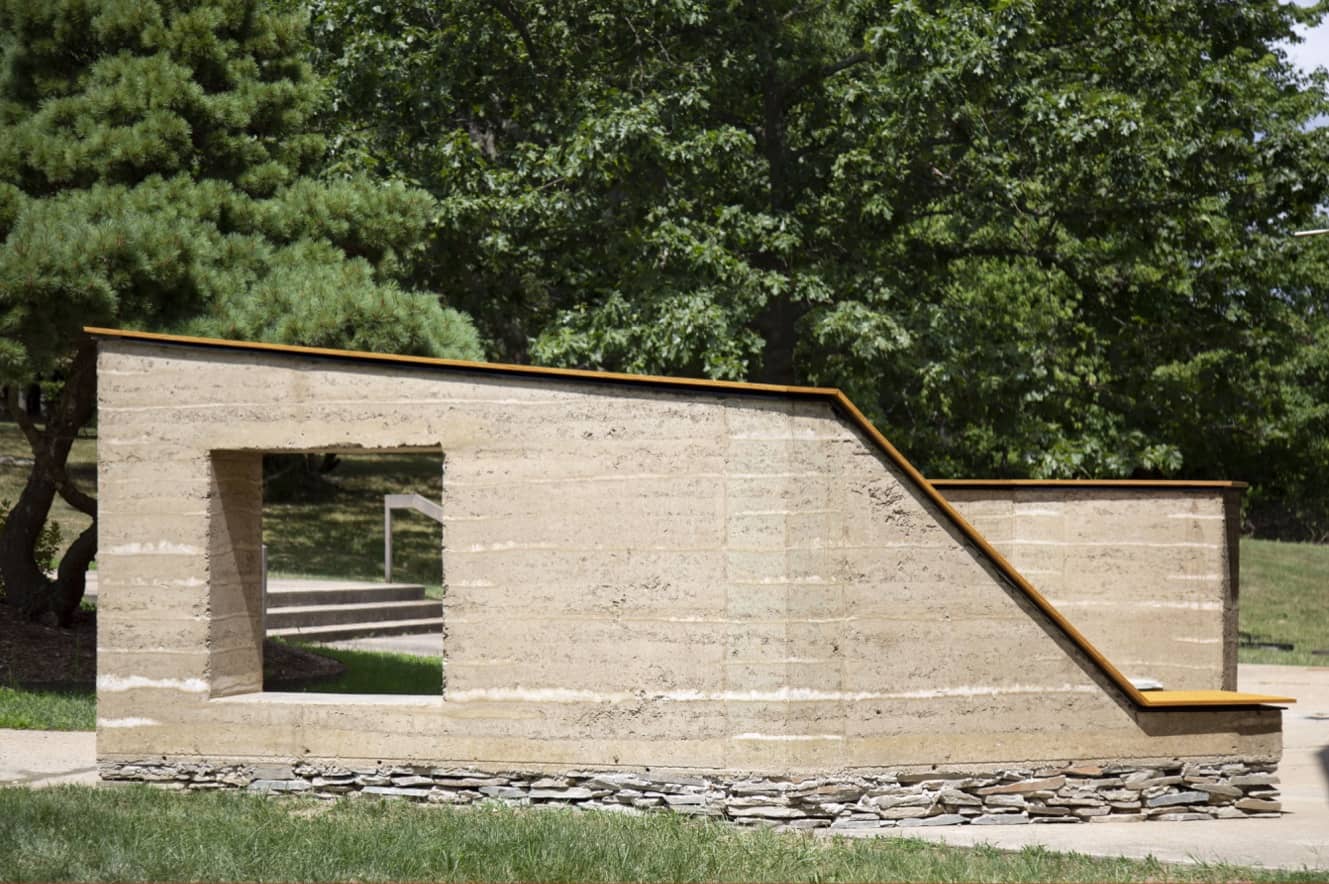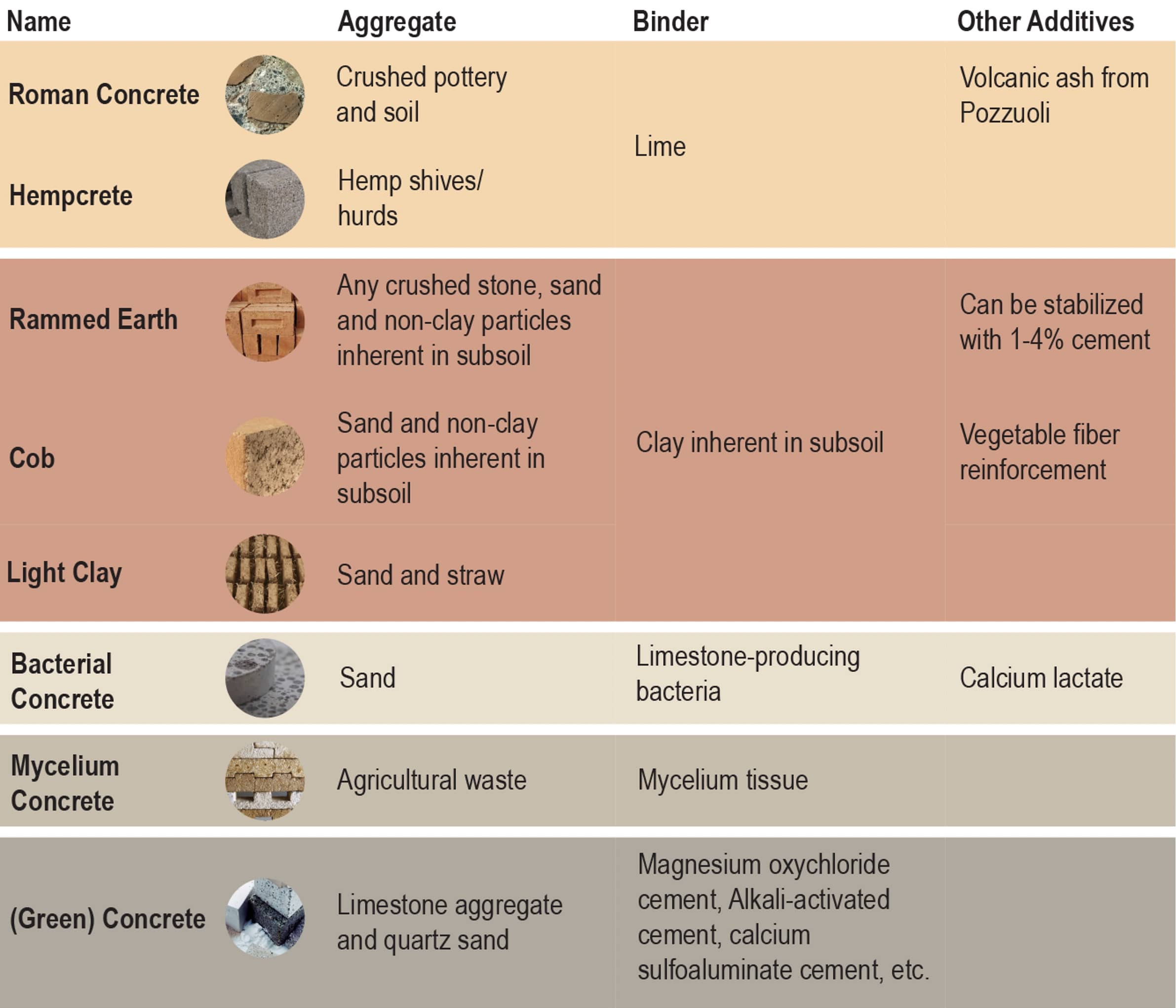
www.buildingsandcities.org/insights/commentaries/world-without-concrete.html
A World without Concrete?

Concrete has high environmental impacts. Can the construction industry reduce the volume of concrete that is used?
Can a world without concrete exist? Lola Ben-Alon (Columbia University) offers a lexicon of a myriad of concrete possibilities and questions where these materials stand in the hierarchy of decarbonising the built environment.
Concrete, or in its original Latin name concretus, is a 'compact' or 'solidified' matter made of aggregate and binder. As such, concrete can be defined as an artificial rock that concresceres (the Latin phrase for 'grows together') from the interaction between the aggregate and binder to form a mass assembly. The term 'concrete', as we know it today, was introduced only in the mid-nineteenth century, to promote Portland cement's durability and transportability, as part of a technological leap that expanded colonial scopes (Martinez 2017). Today, Portland concrete is embedded in almost every project and is the most used building material worldwide. It is also revealed to be a climate villain that accounts for almost 10% of global carbon emissions (Sauto-Martinez et al. 2018).
The idea of 'a world without concrete' raises the question whether concrete is the nemesis, when in fact it embodies a formula that should be the champion for material wisdom (King 2017). Concrete, or artificial rock, is not one specific material, or a set of materials. Instead, it is a formula, a 'recipe' for human-made mass or cave-like material mixtures.
Is it possible to re-frame the perceptions and understandings of what concrete is? Is it possible to have a material that is not chemically dependent on the binding capabilities of Portland cement? And if so, what could be the roles of softer, perhaps less structural non-cementitious mass materials? In other words, should Portland cement be limited to structural elements that need to withstand an X-structural load threshold (where X is a function of conditions such as seismic context, building height, programmatic use, etc.) of large structural loads?
New alternatives for 'engineered rock'
Redefining what concrete is informs the possibilities of new source materials for concrete and cave-like technologies that challenge supply chain mechanisms of the construction industry and assert a critical mode of thinking in relation to environmental, social, and cost life cycle impacts. The colonialist 'concrete age' search for an 'actual and solid' material performance that can be hyper-durable and transportable to faraway lands should be recalibrated to address global challenges. We need to re-introduce concrete as a material that is biodegradable-unless-maintained, locally available, locally harvested and regionally benefited. Geo-bio earth materials, agro-by-products, and naturally-occurring biopolymers (aka bioplastics) are part of the natural building paradigm, which offers a natural alternative to concrete, where clay-rich soils, lime, resins, enzymes, and living substates replace cement as a binder, and natural fibers replace steel rebar as reinforcement. These types of aggregate-glue mixtures, including earth-concrete materials, hempcrete, mycelium blocks, and, of course, bio- and "green" concrete, may all be grouped under the concretus terminology.
The basic 'recipe' for an artificial rock includes three main components: (1) aggregates that provide compressive strength, (2) a binder that dictates the workability and viscosity performance of the matrix, and (3) the reinforcement and other additives that provide tensile strength, among other parameters. Modern concrete uses Portland cement as a binder, produced by heating lime, iron, silica, and alumina to clinkering temperatures of 2,500-2,800 oF, the most energy-intense binder of all historical forms of concretes.

However, other forms of concrete are possible, as shown in Figure 1. In Roman antiquity, the binder was lime infused with volcanic ash sourced from Pozzuoli in Italy, requiring temperatures of roughly 1,650 oF. Lime can also be used for hempcrete, where hemp shives or hurds act as an aggregate (not as a fiber reinforcement, as many might think). Clay rich soils have been used as binders since antiquity, in combination with vegetable fibers, to form various modes of earth-based mass. The clay-rich soil is an example for a non-calcinated, raw binder (zero heat invested), to form assemblies such as rammed earth and cob, which are load bearing monolithic mass wall systems.
This basic recipe can be further adjusted and adapted to respond to local geoclimatic and agricultural contexts and provide a diversity of styles and techniques, as well as a range of thermal possibilities. Light straw clay is a non-load bearing tamped insulative material that can perform as a hygroscopic mass infill. Mycelium concrete uses thermally insulative agricultural waste, from fibers to sawdust, held together by the growth of a mushroom tissue. These alternatives achieve compressive strengths that vary between of 0.5-50 MPa, and though lower than Portland concrete, this mechanical performance can be sufficient for low rise structures, an inevitable majority - approximately 75% - of new construction worldwide (US EIA 2018).
Avoiding concrete or stop building?

Can society do without concrete? Or can R&D efforts create concrete with a lower environmental impact to meet targets for 2030 and 2050? Perhaps the better question is - how can society ensure that unnecessary buildings are not built (and who gets to define what is necessary)? If new buildings are created, then how can we avoid creating "a Trophy, Atrophy in a world . . . any trophy is asymmetrically connected to atrophy elsewhere on the planet. This is constitutive of the trophic structure of modern and contemporary architecture" (Moe 2021).
The potential impact of building design should be placed in context. According to The Institution of Structural Engineers: cutting one economy flight from London to NYC can save 1,600 kgCO2eq, cutting meat, dairy, and beer from an individual's diet can save 2,000 kgCO2eq per year, ceasing the use of a car can save 3,000 kgCO2eq per year. However, if you achieve one project annually with 20% less structural embodied carbon you can save 200,000 kgCO2eq per year (Gibbons & Orr 2020). The impact of the building professions is the most significant over time, since engineers and architects dictate the preliminary massing, arrangement, and materials of a certain design.
New development by itself may be the problem. A critical hierarchy analysis for carbon emissions reduction based on PAS 2080 (Manidaki & Pantelidou 2022) shows that, at the highest priority, society should strive to not build at all, but rather to evaluate the basic need for the asset in the first place. Then, the second priority is to build less, i.e. use existing buildings and improve existing constructions. It is only on the third tier that we should build clever: repurpose and reclaim salvaged materials, use raw and biogenic elements, and catalyze low carbon building, including new forms of 'green' concrete (Figure 2). Hence it is worth exploring not whether the construction industry can do without concrete, but, whether we can actively detach from outmoded development and building practices
Acknowledgements
I would like to extend my gratitude to my friend and colleague, Tommy Schaperkotter, for reviewing this article and for many hours of brainstorming and debating around the topics of matter, materials, and construction ecology.
References
Gibbons, O.P. & Orr, J.J. (2020). How to calculate embodied carbon. Institution of Structural Engineers.
King, B. (2017). The New Carbon Architecture: Building to Cool the Climate. New Society Publishers.
Manidaki, M., & Pantelidou, H. (2022, May). UK PAS 2080 carbon management standard updated in response to net-zero challenge. Proceedings of the Institution of Civil Engineers-Civil Engineering, 175(2), 54-54.
Martinez, D.J.S. (2017). Concrete Colonialism: Architecture, Urbanism, Infrastructure, and the American Colonial Project in the Philippines. (Doctoral dissertation, Columbia University)
Moe, K. (2021). Unless: The Seagram Building Construction Ecology. Actar Publishers.
Souto-Martinez, A., Arehart, J.H., & Srubar III, W.V. (2018). Cradle-to-gate CO2e emissions vs. in situ CO2 sequestration of structural concrete elements. Energy and Buildings, 167, 301-311.
Latest Peer-Reviewed Journal Content
Designing for pro-environmental behaviour change: the aspiration–reality gap
J Simpson & J Uttley
Lifetimes of demolished buildings in US and European cities
J Berglund-Brown, I Dobie, J Hewitt, C De Wolf & J Ochsendorf
Expanding the framework of urban living labs using grassroots methods
T Ahmed, I Delsante & L Migliavacca
Youth engagement in urban living labs: tools, methods and pedagogies
N Charalambous, C Panayi, C Mady, T Augustinčić & D Berc
Co-creating urban transformation: a stakeholder analysis for Germany’s heat transition
P Heger, C Bieber, M Hendawy & A Shooshtari
Placemaking living lab: creating resilient social and spatial infrastructures
M Dodd, N Madabhushi & R Lees
Church pipe organs: historical tuning records as indoor environmental evidence
B Bingley, A Knight & Y Xing
A framework for 1.5°C-aligned GHG budgets in architecture
G Betti, I Spaar, D Bachmann, A Jerosch-Herold, E Kühner, R Yang, K Avhad & S Sinning
Net zero retrofit of the building stock [editorial]
D Godoy-Shimizu & P Steadman
Co-learning in living labs: nurturing civic agency and resilience
A Belfield
The importance of multi-roles and code-switching in living labs
H Noller & A Tarik
Researchers’ shifting roles in living labs for knowledge co-production
C-C Dobre & G Faldi
Increasing civic resilience in urban living labs: city authorities’ roles
E Alatalo, M Laine & M Kyrönviita
Co-curation as civic practice in community engagement
Z Li, M Sunikka-Blank, R Purohit & F Samuel
Preserving buildings: emission reductions from circular economy strategies in Austria
N Alaux, V Kulmer, J Vogel & A Passer
Urban living labs: relationality between institutions and local circularity
P Palo, M Adelfio, J Lundin & E Brandão
Living labs: epistemic modelling, temporariness and land value
J Clossick, T Khonsari & U Steven
Co-creating interventions to prevent mosquito-borne disease transmission in hospitals
O Sloan Wood, E Lupenza, D M Agnello, J B Knudsen, M Msellem, K L Schiøler & F Saleh
Circularity at the neighbourhood scale: co-creative living lab lessons
J Honsa, A Versele, T Van de Kerckhove & C Piccardo
Positive energy districts and energy communities: how living labs create value
E Malakhatka, O Shafqat, A Sandoff & L Thuvander
Built environment governance and professionalism: the end of laissez-faire (again)
S Foxell
Co-creating justice in housing energy transitions through energy living labs
D Ricci, C Leiwakabessy, S van Wieringen, P de Koning & T Konstantinou
HVAC characterisation of existing Canadian buildings for decarbonisation retrofit identification
J Adebisi & J J McArthur
Simulation and the building performance gap [editorial]
M Donn
Developing criteria for effective building-sector commitments in nationally determined contributions
P Graham, K McFarlane & M Taheri
Join Our Community

The most important part of any journal is our people – readers, authors, reviewers, editorial board members and editors. You are cordially invited to join our community by joining our mailing list. We send out occasional emails about the journal – calls for papers, special issues, events and more.
We will not share your email with third parties. Read more



Latest Commentaries
COP30 Report
Matti Kuittinen (Aalto University) reflects on his experience of attending the 2025 UN Conference of the Parties in Belém, Brazil. The roadmaps and commitments failed to deliver the objectives of the 2025 Paris Agreement. However, 2 countries - Japan and Senegal - announced they are creating roadmaps to decarbonise their buildings. An international group of government ministers put housing on the agenda - specifying the need for reduced carbon and energy use along with affordability, quality and climate resilience.
Building-Related Research: New Context, New Challenges
Raymond J. Cole (University of British Columbia) reflects on the key challenges raised in the 34 commissioned essays for Buildings & Cities 5th anniversary. Not only are key research issues identified, but the consequences of changing contexts for conducting research and tailoring its influence on society are highlighted as key areas of action.